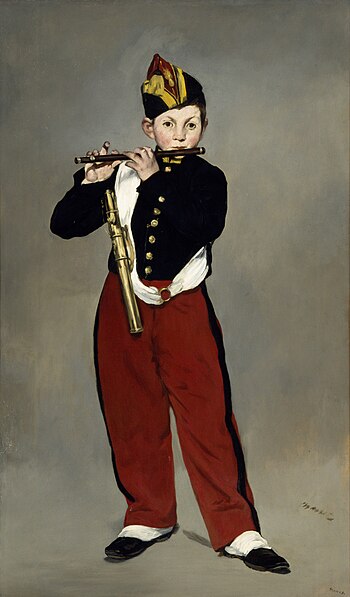 |
| Edouard Manet: Young Flautist, or The Fifer, 1866 (Photo credit: Wikipedia) |
The fife is a type of flute that is fairly similar to the piccolo. It is a transverse flute that emits a high pitched sound that is louder than the piccolo because of its design. It has a narrower bore that causes the higher pitch. This flute was most often used in marching bands and the military, possibly because of its loud and distinguishing sound. It was not often used in musical orchestras in the past, though it was used in some folk music, and it does not appear to be one of the more popular flutes in general, though it is still around for people who want to take up the fife as their musical instrument of choice.
The fife is an older type of flute that appeared to have first been developed in Switzerland, during the 1300s. When it was first created, it was used in the traditional folk music of the time and was a common instrument used to accompany dancing. Its use was not limited to the upper class; it appears that all social classes were able to enjoy the music as well as play the instrument. In modern music, the fife is still used in different forms of folk music, as well as in the blues music, Celtic music and folk rock.
Like most flutes, the fife is fairly simple in design. The fife is made out of a narrow tube that has six holes in it that are covered by the musician's fingers to play different notes. There are some fifes that have more than six holes, but these are usually added for chromatics. Unlike some of the other flutes made today, the fife is often made out of wood, such as rosewood and mopane, though it is occasionally made out of plastic or metal. The fife is made in a particular key; either in B flat, C or D. Fifes made in the key of C and D are more common than the ones made in B flat.
 |
| Fife-wooden, civil war era (Photo credit: Wikipedia) |
The fife is a small instrument that is very easy to carry just about anywhere. Fifes made out of different material and are made in different keys have unique sounds, and can sometimes make it difficult for someone to pick out the fife of their choice when they decide it is the instrument they would like to adopt. Most people looking for the right fife will focus on the sound that each type makes and will pick the one that has the sound that is most attractive to them.
This instrument is also fairly inexpensive to purchase and the music is relatively easy to acquire. When first learning how to play an instrument, this is probably one of the best ones to start with. It takes some time and practice, but it allows a new musician to learn how to read and follow sheet music, as well as learn how to control their breathing so that they can create the sound that they want. The fife might not be the first instrument that comes to mind when a person is thinking about what they would like to play, but it is certainly a good choice for someone new to music.
Article Directory: EzineArticles |

No comments:
Post a Comment